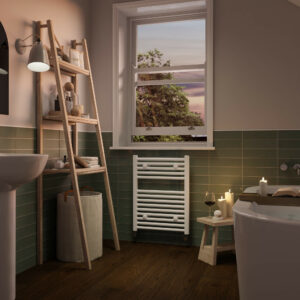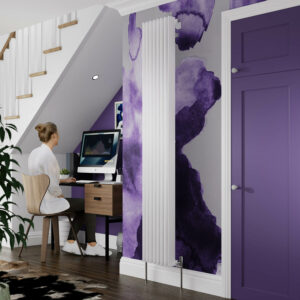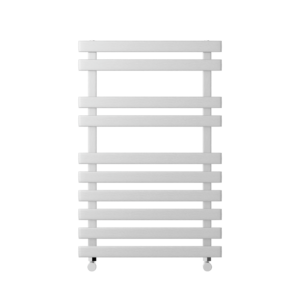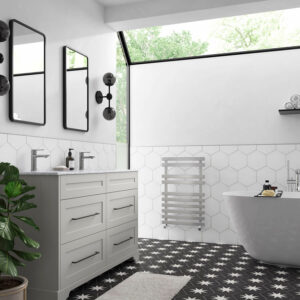With the chill of Winter seeping into our homes, having the right radiator placement can make all the difference when wanting to create a cosy environment. Your radiator isn’t just a metal fixture in the corner of the room, it’s essential to home comfort, so where it is placed in a room is an important consideration.
To help you know where to position radiators for maximum effect, below you’ll find some quick tips and radiator positioning advice to help with installation and usage. That way, you can plan where to place your new radiators before purchase and enjoy long-term warmth that is as efficient as possible.
Positioning Near Exterior Walls
Exterior walls are often the coldest parts of a room, often leaking precious warmth. Positioning a Suitably sized single panel radiator against these walls can help create a thermal barrier, keeping the cold at bay and ensuring your comfort. However, because it is an exterior wall, the radiator may need to work harder to counteract the cold air, keeping the room warm. This will need to be considered, especially as many homes traditionally have radiators under windows which are on the exterior wall (more on this in the next point). It can work more efficiently against an interior wall, but this will depend on the piping and layout of the room.
Placement Under Windows
The area under your window on the exterior wall could become a cold spot. Installing a radiator here neutralises the cold air coming from the window, which is why traditionally this was an ideal place for traditional convector radiators and more recently column radiators, with the natural air flow helping to distribute heat from the radiator. However, as modern homes more often than not have double glazing which helps to stop heat from escaping, and minimises the cold air coming in, this isn’t as much of a necessity. Depending on the room, it can still be easier to place convector radiators under the window especially if the pipes are already positioned here, and as you wouldn’t tend to have furniture directly in front of the window.
Avoiding Furniture and Obstructions
Furniture can absorb the heat meant for your room, so if you place items such as sofas, beds, curtains, or other large items directly in front of a radiator, it will not work as well for heating the room. If you do so, you will potentially have to keep the heating on for longer and even turn the heat up higher to be as effective. To avoid this, keep the radiator clear from any obstructions, so if installing in a room that has a lot of furniture such as a kitchen or living room, choose a wall that is relatively open and will not impact heat distribution. Again, this is why placing it under a window can be effective. Our slimline radiators offer the perfect solution, delivering maximum warmth while fitting seamlessly into your home’s aesthetic, as well as space-saving radiators that are ideal for more compact rooms.
Radiator Sizing and Output
Size matters when it comes to the radiators you choose. Small radiators might struggle in a large room, while larger designer radiators could overheat a small space. We offer a variety of sizes to ensure you get the perfect fit for efficient heating no matter where you place your radiator, as long as you have the correct dimensions for the room. This is where using our BTU calculator can help you find the right fit based on the room’s features and size.
Radiator Valves and Controls
Control is key for efficiency, no matter where you place your radiators. With our thermostatic radiator valves (TRVs),you can adjust the temperature room by room on each radiator, saving energy and money. Thermostatic radiator valves are an easy upgrade that can make a significant difference to your heating bill. Having the best position for radiators in a room helps on one hand, but if they are still not used effectively and you are heating rooms you don’t necessarily need to, this will still mean you could have a higher-than-expected bill. Use TRVs to ensure you make the most of your well-positioned radiator.
Balancing Multiple Radiators
If you have multiple radiators in a room, usually a larger space, balancing them ensures even heat distribution. You’ll want the best setup to achieve a consistent temperature throughout the room, ensuring every corner is pleasantly warm. You should look to have the room sized accordingly for the correct radiator size and amount, and if it is required to have more than one, place additional radiators on separate walls rather than placing them close together, for example, on opposite walls and diagonally opposite each other
Radiators in Specific Rooms
Each room has its own heating needs, so to help you perfectly position a radiator, you should choose the type of radiator for the job. A towel radiator for your bathroom or en-suite can be an ideal option when compared to fitting a horizontal double panel radiator, not only because it has the added function of somewhere to place wet towels, but because it is more slimline and can maximise the vertical space. Similarly, vertical radiators can be ideal for a kitchen due to the lack of wall space from kitchen units and furniture. The type and orientation will help you choose the best position for radiators in a certain room.
Getting Professional Advice
Sometimes, it can be difficult to make a decision yourself, especially if you’re not an expert and have not previously installed radiators or wall mounted electric radiators. At Stelrad, we can help you if you are unsure, and along with using our BTU calculator, we can recommend the best options for your home. You could also look to consult a central heating engineer for the radiators or an electrical contractor/Installer for the electric radiators to help with installation so that you can get an informed opinion on radiator positioning advice before installation.
So, assess the room before you choose to buy and consider where to position radiators so that you can then check the type and size you need. From standard radiators to electric radiators, we have a full selection ideal for any room to meet your unique circumstances and requirements.







